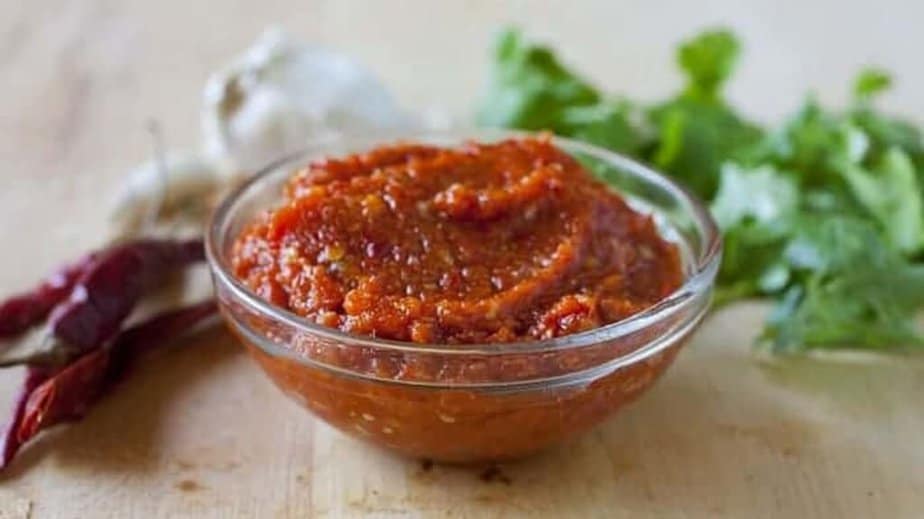Looking for a good chili paste substitute? If you haven’t got chili paste and want to swap in something else, then here you’ll find the best ingredients that can save your recipe.
Occasionally, every cook encounters a situation wherein he or she suddenly finds that a crucial ingredient in the recipe is missing. An ingredient like chili paste has limited use in regular cooking, thus most houses don’t keep it in stock always. However, you can easily fill up the vacuum of chili paste with a few other common cooking ingredients in your pantry.
What Is Chili Paste?
Chili paste is a condiment used in many Chinese, Thai, Mexican, Indonesian, and Indian recipes. This condiment is made with hot chili peppers as the base has a close resemblance to tomato sauce in appearance.
Basically, chili paste is a spicy, fiery red condiment using fresh or dried red chilies. In addition, it may be seasoned with other ingredients like vinegar, garlic, ginger, onion, salt, oil, sesame, or any seeds.
Peculiarly, you’ll find several types of chili paste from Thai red chili paste to Indonesian green chili paste. Besides the various types of chili peppers used to make it, a variety of other ingredients are also used in chili pastes, thus they come in different flavors, colors, and uses.
The type of paste varies from region to region according to the cooking tradition of the locality, but also on the types of peppers available in the region. Some of the best-known chili pastes from across the world are such as ancho paste, Calabrian chili paste, curry paste, Doubanjiang, Gochujang, harissa, miso, Sambal oelek, Sriracha, and Thai chili paste.
Best Chili Paste Substitute
Chili paste has limited uses in cooking and it isn’t a regular ingredient in common households. Even without chili paste, you can easily manage your recipe which actually calls for it. Here are some of the best substitutions for chili paste that really work.
1. Hot Sauce
When you don’t have chili paste, get hold of hot sauce instead. These two condiments have similar ingredients, flavor profiles, textures, and uses. Especially, the Louisiana-style hot sauce which is rich in chili pepper, vinegar, and salt is a close match for the common red chili paste.
Sriracha hot chili sauce has the best resemblance to chili paste both in flavor and appearance. Unlike other hot sauces, Sriracha has a thicker consistency akin to chili paste.
The only disadvantage in using hot sauce in place of chili paste is the dominance of vinegar flavor in most varieties of hot sauces. Some chefs recommend stirring a pinch of baking soda into the hot sauce to neutralize the vinegar flavor.
2. Tomato Paste + Ground Chili Pepper
Tomato paste resembles chili paste in color and consistency though they vastly differ in taste. Still, tomato flavor is loved by most of us. However, a combination of ground chili pepper and tomato paste is a credible alternative to chili paste. To every three tablespoons of tomato paste or ketchup add two teaspoons of ground cayenne pepper, red chili pepper flakes, or chili powder to get this combination right. Substitute chili paste with this combination of tomato paste and chili pepper and it works great in most recipes.
3, Crushed Red Pepper Flakes
Red pepper flakes or crushed red pepper is a condiment or spice consisting of dried and crushed red chili peppers. These flakes provide the same heat as chili paste and work well as a substitute in recipes that simply require a hot flavor.
Pepper flakes lack the consistency of paste or sauce. If the consistency and color of chili paste are necessary for your dish, then make a mixture of tomato sauce and red pepper flakes. Another method is to make a mixture of one tablespoon of soy sauce, one teaspoon of sugar, and a tablespoon of red pepper flakes and blend them into a paste-like consistency.
4. DIY Chili Paste
The finest substitution for a store-bought chili paste is making your own chili paste. It needs only a few common ingredients and takes only a little time to blend them into a paste; similar to making salsa. A homemade chili paste gives you the freedom to select the ingredients according to the desired flavor profile of your dish.
A homemade chili paste can be made from dried or fresh chilies. Generally, seeds and stems are removed from the whole chilies. Add essential ingredients like olive oil, garlic, onion, and any other spice to the chilies and hydrate them in hot water at a low heat level for 20 minutes or until they turn soft and mushy. Stir the mixture frequently while you hydrate and soften them in hot water. Then, transfer the pulp-like mixture into a food processor, add salt, and process the mixture into a paste-like consistency. When the paste is ready, transfer it into an airtight glass container and store it in the refrigerator or use it in your cooking.
Normally, the shelf life of homemade chili paste with water is around two weeks. Once it’s taken out of the fridge, make sure to put it back into the fridge before it thaws to room temperature.
Final Thoughts
In conclusion, chili paste is a versatile condiment made from chili peppers and various seasonings, essential in many Asian and Mexican recipes, with regional varieties like ancho paste and Gochujang.
When unavailable, suitable substitutes include:
- hot sauce: especially Sriracha, for a similar texture and heat
- a blend of tomato paste and ground chili pepper: for color and consistency
- crushed red pepper flakes: for an easy heat addition
- a homemade version: allowing customization of ingredients and flavors.
These alternatives ensure that the desired spicy profile in dishes can be maintained even without traditional chili paste.
Related stories:
